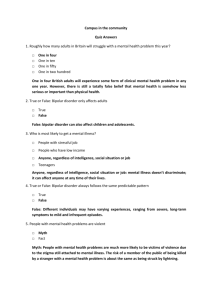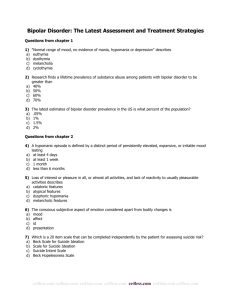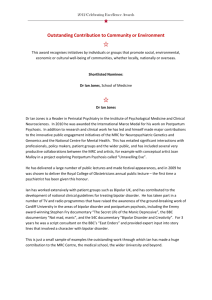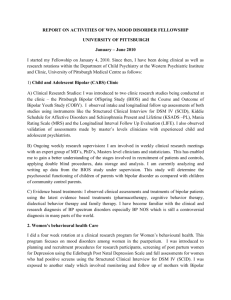Bipolar Disorder - Appalachian State University
advertisement
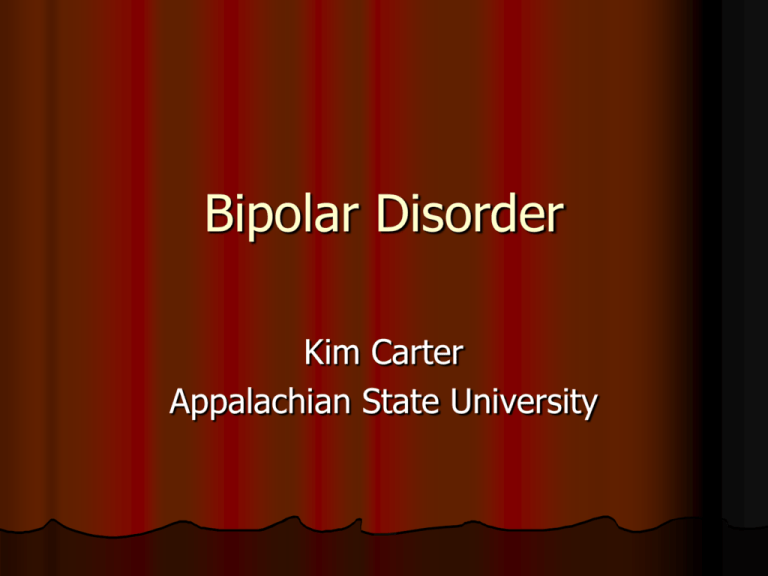
Bipolar Disorder Kim Carter Appalachian State University What is Bipolar Disorder ? It is a spectrum of affective episodes including: Major depressive episode Manic episode Mixed episode Rapid cycling Hypomanic episode The DSM-IV categorizes it into: Bipolar I Disorder Bipolar II Disorder Cyclothymia Bipolar N.O.S. Bipolar I or II Disorder ? What is the difference? Bipolar I 1+ manic or mixed episodes May have other mood episodes Bipolar II 1 + major depressive episodes AND 1 + hypomanic episodes Never manic or mixed episode Prevalence Rates and Course Bipolar I Lifetime: .4-1.6% = in men and women Men>manic episodes Women>dep episodes Women>rapid cycling Ave. age onset = 20 Recurrent 60-70% of manic episodes occur before or after a depressive episode Prevalence Rates and Course Bipolar II Lifetime: .5% May be more common in women than men Men>hypomanic than depressive episodes Women>depressive than hypomanic episodes Women>rapid cycling 60-70%of hypomanic episodes occur before or after a depressive episode Interval between episodes decrease with age Less data overall Cyclothymic Disorder Chronic fluctuating periods of hypomanic and depressive symptoms for a 2 year period, absence of symptoms < 2 months Lifetime: .4-1%, equal among men/women Onset adolescence or early adulthood 15-50% risk of developing into Bipolar Disorder Bipolar Disorder N.O.S. Rapid cycling (days) between manic and depressive symptoms Recurrent hypomanic episodes without intercurrent depressive symptoms Hypomanic episodes, along with chronic depressive symptoms, that are too infrequent to qualify for a diagnosis Etiological Factors Hereditary Factors Biochemical Hypothesis Stressful Life Events Cognitive Styles as Vulnerabilities Hereditary Factors 1st degree relatives have significantly higher rates Twin and adoption studies indicate genetic vulnerability May reflect environmental factors Biochemical Hypothesis Deficiency in norepinephrine Dopamine implicated in the study of mania and psychotic symptoms Serotonin levels have also been implicated Stressful Life Events Linkage between significant life events and affective abnormalities Negative, traumatic life events trigger mania Low social support, low self-esteem trigger depressive Family Environment Expressed Emotion may be an important factor-families with high expressed emotion have poor coping skills Families with high levels of EE are linked to greater levels of symptom relapse and poor treatment outcome, as compared to clients in families with low levels of EE Cognitive Styles as Vulnerability Factors Individuals with negative attributional styles combined with stressful life events can predict hypomanic, manic and depressive mood shifts Mania and depression are related to an ongoing sense of low self-worth List of Prognostic Indicators of Treatment Outcome 1. 2. 3. 4. 5. 6. 7. 8. Suicidality Presence of a personality disorder Quality of family and social support Substance use History of severity of prior episodes Bipolar I type is most severe Treatment onset-the sooner the better Age of onset-the younger the more severe Bipolar DisorderMajor Public Health Issue Overall economic burden is estimated at $45 billion dollars annually Costs of treatment for an individual exceed $17,000 per year 1 in 3 people with bipolar disorder fail to comply with medications Non-adherence to treatment often results in hospitalization and suicide B.D. is often comorbid with other disorders. Differential diagnosis should also be considered. Specifically with: Bipolar vs. unipolar ADHD Schizophrenia Substance abuse Axis II Substance Abuse and Bipolar Disorder B. D. is the highest Axis I disorder comorbid/concurrent with substance abuse 21-61% of people with B.D. abuse or are addicted to substances as compared to 3-13% in the general population B.D. is second to antisocial personality disorder in terms of concurrent substance abuse Substance use adversely effects medication, produces earlier onset of symptoms and often leads to hospitalization Bipolar Disorder and Personality Disorders Approximately 50% of all Bipolar patients also meet criteria for a personality disorder The most common comorbid conditions are in cluster B and C The most common Cluster B disorders include Antisocial, Borderline, Histrionic, Narcissistic The most common Cluster C disorders include Avoidant and Obsessive-Compulsive Major Issues that Impede Diagnosis and Recognition of B.D. Lack of reliable assessment tools for Bipolar Disorder Misdiagnosed as unipolar depression Children, adolescents and young adults are often diagnosed with ADHD People often do not have clear cut, discrete mood episodes Mania if often unrecognized or considered irritability/ aggression Psychotic features are often mistaken for Schizophrenia Unwillingness of the client to seek treatment Lack of insight from client in mood episodes Clinicians are not looking for manic/hypomanic episodes- and reliance on self-reports Major Issues that Impede Diagnosis and Recognition of B.D. Clinicians are not always looking for manic/hypomanic episodes and have a strong reliance on self-reports NOT forming a strong alliance throughout assessment period Poor assessment by the clinician of family and personal history Denial/Stigma may cause clinicians to under diagnose and clients may not accept the diagnosis Treatment Overview-phase I • Perform a careful diagnostic evaluation • Ensure the safety of client and consider the proper treatment setting • Establish & maintain a strong alliance • Continually monitor psychiatric status • Referral to psychiatrist SUICIDE RISK Must Be Continually Monitored • Suicide completion rates in patients with B.D. 10-15% – Presence of suicidal or homicidal ideation, intent, plans – Access to means – Psychotic features, severe anxiety – Substance abuse – History of previous attempts – Family history or recent exposure Assessment Procedures • Conduct a solid structured clinical interview • Obtain a longitudinal hix of mood episodes • Conduct careful observations of the client in session. Collect third party reports on data from various sources in a variety of settings ie. home, work, school • Obtain a family history of illness. Remember to ask detailed questions beyond “Has anyone been diagnosed with…” Ask questions geared around common symptoms like, do you have any relatives that committed suicide, extremely impulsive, abuse substances Assessment Tools • The following tools will aide in the evaluation and diagnosis of a client: • • • • • • PAI, MCMI The Mood Chart (Social Rhythm Metric) Mood Disorder Questionnaire Self-Control Behavior Scale Beck Depression and Hopelessness Inventories Basc inventories for 3rd party reports Continue to Evaluate and Provide Safety Nets Throughout the Process • Evaluate treatment setting- in or out patient, safety of the home • Contract for safety and have a crisis plan with clients to reduce risk of suicide • Inform and educate family about risks and triggers • Limit access to weapons, cars, credit cards, bank accounts, etc. Therapist Variables • The therapist has a large impact on treatment outcome • Positive Predictors – Maintain a strong therapeutics alliance – Consider the family or couple as a system and integrate them into the treatment plan – “biopsychosocially” understand, integrate and focus on medication compliance although psychosocial issues may seem more interesting and pressing Treatment Overview-phase II • Educate the patient and family • Enhance treatment adherence • Promote awareness of stressors • Anticipate and address signs of relapse • Management/Maintenance/Improvement Psychoeducation for family and client The patients and family should be educated about Bipolar Disorder as an illness, using the Diathesis Stress Model. Explain that there is a strong genetic component and that stress can lead to, or trigger, an episode. Through treatment, clients will learn to problem-solve, limit mood swings, and establish routines to help avoid unnecessary stressors. Psychoeducation for family and client • Refers not only to the illness, but also the treatment approach • Explain and outline, in basic terms, the tx plan • Explain the need for cooperation of client and family Specific Interventions • Medication-refer to psychiatrist • Interpersonal & Social Rhythm Therapy • Cognitive Behavior Therapy • Family, couples therapy • Group therapy Psychosocial Treatments are useful for Bipolar Disorder by… • Increasing medication compliance • Improving quality of life • Enhance coping mechanisms for stress Psychosocial Interventions Include individual, family and group psychotherapies • • • • • The main goals: Educate about illness and tx Enhancing acceptance of illness Improve monitoring of changes in mood, sleep and vigilance for warning signs of relapse Establish skills for coping with and limiting stress Psychosocial Interventions • Main goals continued: • Identifying interpersonal difficulties commonly arising • • • • from being ill and refining skills for managing them Deriving support and encouragement from sharing experiences with others living with Bipolar Managing adverse experiences with long-term pharmacological tx Reducing the amount of EE in the home environment Dealing with the impact of the disorder on family Interpersonal and Social Rhythm Theory • Based on the hypothesis that stressful life events • • affect the course of the illness in part by disrupting daily routines and social rhythms (sleep-wake cycles) Disruption in social rhythms in turn disrupts the circadian cycles Encourages clients to recognize the impact of interpersonal events on social and circadian rhythms Interpersonal and Social Rhythm Theory • Two main goals-help clients recognize and • • understand the social context associated with mood disorder symptoms and to encourage clients to recognize the impact of interpersonal events on their social and circadian rhythms Regulate rhythms to in order to gain control over their mood cycling. Final goal is to identify and understand interpersonal problem areas-grief over the loss of their “healthy” self, interpersonal disputes and deficits, role transitions Interpersonal and Social Rhythm Theory • Social Rhythm Metric-self monitoring chart for • • • activity, stimulation, mood, times to understand the dynamics of social and circadian rhythms Clients learn balance in daily patterns of social activity, patterns of social stimulation and sleep cycles Clarifying and interpretive interventions for interpersonal interactions Learn to label problematic interpersonal patterns Cognitive Behavior Therapy • Basic understanding that mood swings are partly a function of negative thinking patterns • Alleviated through behavior activation and cognitive restructuring strategies • Four stage process beginning with psychoeducation and presenting the Diathesis-Stress Model CBT & Diathesis Stress Model • Using cognitive skills to weigh against emotional • • • • waves and behavioral impulses Improving hopefulness to reduce risk of suicide Weigh pros and cons of important life decisions more methodically and with greater objectivity Modifying perceptions of marital and family interactions Reducing the harmful sense of stigma and shame CBT-Four phase strategy • 1. Psychoeducation • 2. Introduce cognitive behavioral skills to cope • with mood episodes. Many clients find it hard to distinguish between mood episodes and prodromes. Using techniques like the mood chart and self-monitoring clients are taught to minimize goal directed behavior during mania and immobile behavior during depression. This model of how thought, behavior and mood affect each other helps clients grasp the CBT techniques. CBT-Four phase strategy • 3. Importance of routine sleep- it has been observed that disruption in sleep cycles may lead to more episodes. Clients are exposed to behavioral skills such as activity scheduling as a useful means of establishing systematic routines • 4. Dealing with long term vulnerabilities-carefully assessing past triggers allows the client to identify themes that may help in future relapse CBT and Bipolar Disorder • NOT talk therapy, requires active collaboration • Structure of session– – – – assessing weekly mood chart reviewing homework prioritize topics open ended questions to facilitate alternative ways of thinking about situations – feedback – assign new homework CBT techniques • Teach self-monitoring with thought records • Advance problem solving • Maximize homework adherence • Assessing schemas-target long standing cognitive vulnerabilities • Recognize negative life events as triggers • Continued goal setting Family and Couples Therapy • Designed for problem solving and communication • • • • • training for couples and families Psychoeducation should address guilt, shame, fear Life issues will remain, but the ability to cope is greatly improved Family environment may be altered to prevent future relapse-minimize EE, remove weapons Enhances overall treatment compliance for the client and improves quality of life May be ongoing (in conjunction with other treatments ie. medication, individual therapy) and later as crisis management Group Therapy • Various group programs available, but they all • • • • have basically the same features: Begins with psycho-education-usually 5 sessions Combines techniques from CBT and IPSRTusually 6-10 sessions Focus on relapse prevention, understanding triggers Dialectical Behavior Treatment can be an effective group format for clients Termination Consider the “dental model”-tx never really ends, but becomes maintenance Stress the need to continue medication Booster sessions may provide the client with necessary help Solidify good self-help habits to reduce future relapse Consider crisis management and develop a plan References American Psychiatric Association Steering Committee on Practice Guidelines (2004). Practice guidelines for the treatment of patients with bipolar disorder, In American Psychiatric Association Practice Guidelines for the Treatment of Psychiatric Disorders: Compendium 2004 (pp. 526-612). Arlington: American Psychiatric Association. Buaer, M. & McBride, L. (1996). Structured Group Psychotherapy for Bipolar Disorder: The Life Goals Program. New York: Springer Publishing Company. Huxley, N., Parikh, S. & Baldessarini, R. (2000). Effectiveness of psychosocial treatments in Bipolar Disorder: State of the evidence. Harvard Review of Psychiatry, 8, 126-140. Nathan, P. & Gorman, J. (2002). A Guide to Treatments That Work. New York: Oxford University Press. Newman, C., Leahy, R., Beck, A., Reilly-Harrington, N. & Gyulai, L. (2002). Bipolar Disorder: A Cognitive Therapy Approach. Washington, D.C.: American Psychological Association. Rivas-Vazquez, R., Johnson, S., Rey, G., Blais, M. & Rivas-Vazquez, A. (2002). Current treatments for Bipolar Disorder : A review and update for psychologists. Professional Psychology: Research and Practice, 33, 212-223. Vieta, E. & Colom, F. (2004). Psychological interventions in Bipolar Disorder: From wishful thinking to an evidence-based approach. Acta Psychiatrica Scandinavica,110, 34-38.

